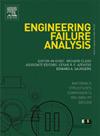饱和岩石低温动态断裂行为研究及断裂韧性修正模型的建立
IF 5.7
2区 工程技术
Q1 ENGINEERING, MECHANICAL
引用次数: 0
摘要
高寒地区岩石长期处于零度以下的低温环境中,昼夜温度变化剧烈,断裂行为复杂,对边坡稳定和工程安全构成威胁。为了研究不同冻结条件下饱和岩石的动态断裂特征及其微观机制,采用高速摄影和数字图像相关(DIC)相结合的分离式霍普金森压杆(SHPB)系统对大理石、花岗岩和砂岩进行了动态试验。利用扫描电子显微镜(SEM)观察了不同低温下断口的形貌。基于试验结果,提出了一种综合冻结致密实和冻胀损伤双重影响的断裂韧性修正模型。结果表明,大理岩和花岗岩的断裂韧性和断裂能在-10℃附近达到峰值后逐渐减小,而砂岩的断裂韧性和断裂能则随着温度的降低而不断增大。裂纹扩展速度也表现出强烈的温度依赖性,大理石和花岗岩的裂纹扩展速度在-10℃达到峰值,砂岩的裂纹扩展速度稳步上升。低温会促进大理石和花岗岩的粗化和霜裂增加,特别是在-10℃以下,而砂岩则呈现致密化趋势,仅在-40℃时出现明显的霜裂。多孔砂岩的断裂行为主要受孔隙冰形成的影响,而致密花岗岩和大理岩的断裂行为主要受热收缩的影响。该模型对所有岩石类型均具有较高的拟合精度,有效捕捉了冻结条件下断裂韧性的复杂演化过程。该研究为认识寒区边坡岩体断裂提供了理论支持,为稳定性评价和工程设计提供了依据。本文章由计算机程序翻译,如有差异,请以英文原文为准。
Study on the subzero temperature dynamic fracture behavior of saturated rocks and development of a fracture toughness modified model
Rocks in high-altitude cold regions are subjected to prolonged subzero temperatures and intense diurnal temperature variations, leading to complex fracture behaviors that threaten slope stability and engineering safety. To investigate the dynamic fracture characteristics and underlying microscopic mechanisms of saturated rocks under different freezing conditions, dynamic tests were conducted on marble, granite, and sandstone using a Split Hopkinson Pressure Bar (SHPB) system combined with high-speed photography and digital image correlation (DIC). Scanning electron microscopy (SEM) was used to observe fracture surface morphology at various subzero temperatures. Based on the experimental results, an empirical fracture toughness correction model was proposed, integrating the dual effects of freezing-induced densification and frost heave damage. The results reveal significant lithological differences in fracture responses: the fracture toughness and energy of marble and granite peak near –10 °C and then decrease, while sandstone shows a continuous increase as temperature drops. Crack propagation velocity also exhibits strong temperature dependence, peaking at –10 °C for marble and granite, and rising steadily for sandstone. Subzero temperatures promote roughening and increased frost-induced cracking in marble and granite, especially below –10 °C, while sandstone shows a densification trend with noticeable frost cracking only at –40 °C. The fracture behavior of porous sandstone is mainly governed by pore ice formation, while dense granite and marble are primarily affected by thermal contraction. The proposed model achieves high fitting accuracy across all rock types, effectively capturing the complex evolution of fracture toughness under freezing conditions. This study provides theoretical support for understanding rock fracture in cold-region slopes and contributes to stability evaluation and engineering design.
求助全文
通过发布文献求助,成功后即可免费获取论文全文。
去求助
来源期刊

Engineering Failure Analysis
工程技术-材料科学:表征与测试
CiteScore
7.70
自引率
20.00%
发文量
956
审稿时长
47 days
期刊介绍:
Engineering Failure Analysis publishes research papers describing the analysis of engineering failures and related studies.
Papers relating to the structure, properties and behaviour of engineering materials are encouraged, particularly those which also involve the detailed application of materials parameters to problems in engineering structures, components and design. In addition to the area of materials engineering, the interacting fields of mechanical, manufacturing, aeronautical, civil, chemical, corrosion and design engineering are considered relevant. Activity should be directed at analysing engineering failures and carrying out research to help reduce the incidences of failures and to extend the operating horizons of engineering materials.
Emphasis is placed on the mechanical properties of materials and their behaviour when influenced by structure, process and environment. Metallic, polymeric, ceramic and natural materials are all included and the application of these materials to real engineering situations should be emphasised. The use of a case-study based approach is also encouraged.
Engineering Failure Analysis provides essential reference material and critical feedback into the design process thereby contributing to the prevention of engineering failures in the future. All submissions will be subject to peer review from leading experts in the field.
 求助内容:
求助内容: 应助结果提醒方式:
应助结果提醒方式:


